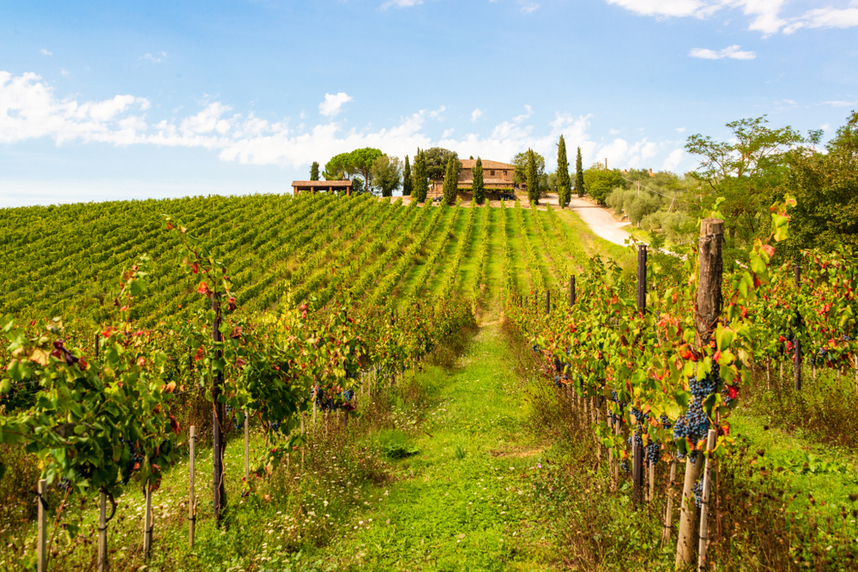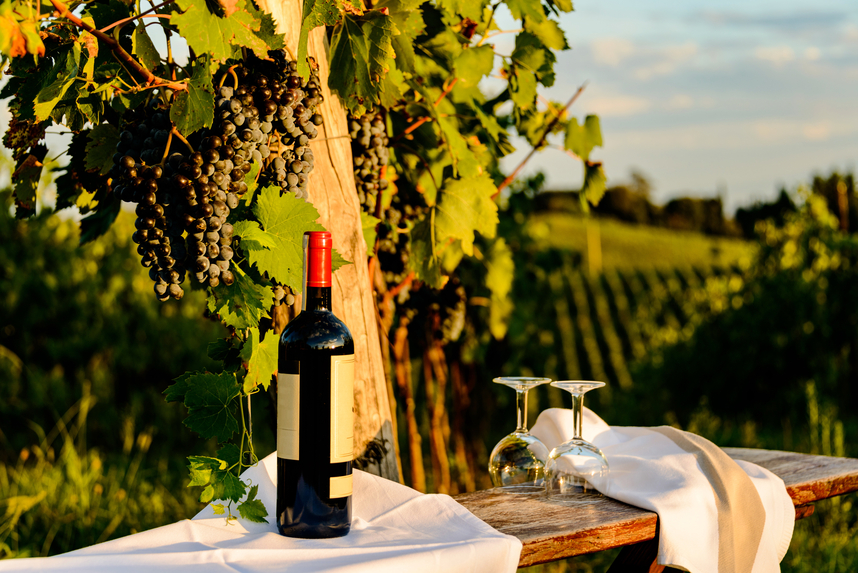Telling the story of Chianti is no easy task, due to the very fragmentation of its identity. However, one can attempt to trace some fundamental stages in the origin of this Tuscan red wine and its evolution, analysing the terroir and the characteristics that have determined the birth of this timeless wine, a pillar of Italian viticulture.
Thus begins the journey of discovery of Chianti, including its history, characteristics and gastronomic pairings!
Chianti: history and evolution of an exceptional Tuscan wine
At the time of the conscious production of the first Tuscan wines by the Etruscans, the vine was not just one of the many crops in the region, but a plant distributed massively along the hillsides of the area. Particularly relevant for fertility was the Chianti area, a true geological and climatic marvel.
The transition from the Roman Empire to the Middle Ages was as culturally varied as it was difficult for the wine produced in Chianti: while the Romans turned wine-growing around, the numerous conflicts and famines of the early Middle Ages weakened the area in terms of production. After the year 1000, however, monastic orders and - from the 12th century onwards - numerous noble families in the area (Ricasoli and Antinori in particular) further refined wine-growing techniques.
Due to its enormous popularity, Chianti - at the time vinified in white - quickly went from being the prerogative of the upper classes to becoming a product appreciated by all. It was precisely this popularity that increased its production, which is why it became necessary to start protecting it officially.
To this end, a start was made in the 15th century to establish the best harvest periods, to protect the designation from counterfeiting and to officially regulate its production around the 18th century. It was to this period and the initiatives of Grand Duke Cosimo III de' Medici that the decision to delimit the Chianti territories, beyond which the production and sale of wine was not permitted.
Another milestone in the history of Chianti dates back to 1874, when the first real composition of this wine was decided upon: a blend of Sangiovese (70%), Canaiolo, Trebbiano and Malvasia (15%), with the addition of 5% other grapes.
In 1924, the Consorzio per la difesa del Vino Chianti e della sua Marca di Origine (Consortium for the Defence of Chianti Wine and its Mark of Origin) was founded to prevent the massive demand for wine from flowing into winemaking outside the delimited area. The image chosen by its creators was an ancient symbol, linked to the political-military power of the region, which became the true icon of Chianti Classico: the Black Rooster.
Production areas, types and characteristics of Chianti wine

Chianti has a wide and varied territory, stretching between valleys and hills, between woods, countryside and olive groves. The hand of man here has moulded nature with a mixture of respect and foresight, creating the ideal terroir for this wine.
The following sub-areas of the Chianti DOCG production area (designation obtained in 1984) can be distinguished:
- Montespertoli: province of Florence. The most prolific area in terms of Chianti DOCG production. The territory is mostly made up of hills, valleys and some slopes between 250-280 m a.s.l., composed of sandstone, limestone residues, sand and clay.
These territorial characteristics give rise toChianti Montespertoli DOCG, an intense ruby red wine with garnet reflections that are amplified with ageing. The nose arrives with vinous notes and refined hints of berries. On the palate, however, it conquers with a good balance of taste and a discreet tannin presence.
- Montalbano: provinces of Florence, Pistoia and Prato. This area is dominated by Chianti Montalbano DOCG, characterised by a ruby red colour tending towards garnet. Notes of violet and morello cherry are added to the vinous scents of this product, accompanying each sip, in which a harmony of fruity aromas stands out. These traits are conferred by the terroir of Montalbano, composed of sandy and loamy soils with the presence of sandstone, situated between 250 and 400 metres above sea level and characterised mainly by a temperate climate.
- Colline Pisane: Province of Pisa. Chianti Colline Pisane DOCG, produced on limestone soils of marine origin, fully reflects this territory. Garnet red in colour on visual inspection, this variety presents a harmonious taste and moderate tannicity, characteristics anticipated during tasting by an organoleptic profile that welcomes notes of violets and spices, with a slight minerality.
- Colli Senesi: Province of Siena. Characterised by predominantly clayey soils and a mild climate, with wet winters and springs and summers that tend to be hot. This area gives birth to its most renowned wine, Chianti Colli Senesi DOCG, a product that releases aromas of wine and violets, with bewitching hints of blackberries. On the palate, however, it is dry and velvety, with a tannicity that is present but not too pronounced.
- Rufina: Province of Florence. Small sub-zone characterised by calcareous soils, with the presence of marl and limestone, located at a maximum of 400 metres above sea level. The good temperature range between day and night gives rise to a refined and gritty wine, perfumed with berries and slightly spicy, with a medium tannicity: Chianti Rufina DOCG.
- Colli Aretini: Province of Arezzo. Characterised by good ventilation and sun exposure, on hills over 300 metres above sea level. From this terroir comes Chianti Colli Aretini DOCG, a clear, deep ruby red wine. It is not only the notes of violet that win you over, but also its vivacious freshness, excellent to savour when this product is still young.
- Colli Fiorentini: in the province of Florence. This area is particularly suited to viticulture, thanks to a temperate climate with good rainfall, hot summers and cold winters. There is also an extraordinary geological richness. The soils are partly composed of river residues, sandy, clayey or rich in sandstone, with a prevalence of soils of marine origin. Chianti Colli Fiorentini DOCG is a balanced wine, brilliant in the glass and perfumed to the nose. Fruity notes stand out, with aromatic floral hints, while on the palate it is soft and full of character, fresh and moderately tannic.
Chianti Classico DOCG
The terroir of Chianti Classico DOCG, between Florence and Siena, deserves a separate discourse. It is the terroir that gave birth to the most prized of Chianti wines and is identified by the unmistakable black rooster label.
Given its historical importance, the production of Chianti Classico wine is governed by strict regulations, which establish the grape varieties (Sangiovese for a minimum of 80%) and the characteristics of the soils, composed of sandstone, limestone, clay, sand and pebbles. The hills are situated at an altitude of no more than 700 metres above sea level. Soils that are too humid, for example at the bottom of the valley, as well as those that are too laden with clay should be avoided.
The specification also stipulates that the wine must be aged until 1 October of the year following the year of harvest.
From these regulations and territorial characteristics comes an excellent wine, clear and red in the glass, characterised by intense nuances and a more complex organoleptic profile than other Chianti wines. To the typical scent of violets - omnipresent in the various exemplars of the appellation - are added notes of iris and red fruits, with balsamic and spicy touches that make the tasting more voluptuous and special. Harmonious and moderately tannic, Chianti Classico is always a certainty, whether at table or as a meditation wine.
Gastronomic pairings and curiosities
There are subtle differences between the various types of Chianti, which differ from one another on the basis of small organoleptic nuances. Bringing these examples to the table therefore means making an excellent impression, regardless of which label you choose. But what are the best Chianti food pairings?
The full-bodied taste of a traditional Florentine steak and the smoky hints conferred by grilling are perfectly matched with the fruity and spicy aromas of a Chianti Classico, characterised by a good balance between acidity and sweetness, as well as balsamic tones and sustained tannin.
If, instead of the Florentine steak, one opts for game, the ideal products are Montalbano or Chianti Colline Pisane, two wines capable of supporting the pungent hints of the meat with their lively persistence, softening them thanks to their fruity notes.
A ribollita with black cabbage, legumes and vegetables, on the other hand, deserves equally savoury and full-bodied wines, such as a Chianti Montespertoli or a Chianti Colli Senesi, harmonious and tasty, soft on the palate and perfumed with violets.
A Rufina DOCG and a Colli Aretini DOCG respectively can be chosen to accompany a cheese board or a platter of local cured meats. The former livens up the tasting thanks to its fruity and spicy tones, while the latter accompanies traditional cold cuts with its young and fresh identity, anything but demanding.
Lastly, it is worth mentioning the Chianti Colli Fiorentini, which - for lovers of white meats - is an excellent companion for a Sunday lunch of barbecued cockerel with side dishes, thanks to its moderate tannicity and dry hints of fruit and spices, which go well with the smoky tones of the chicken!
However, one cannot conclude this dissertation on Chianti wine without recalling the fascination of the legends and curiosities that feature it and that are firmly intertwined with its historical evolution. Three can be mentioned:
- Chianti Gallo Nero is the name by which Chianti Classico wine, vinified within the historic production area, is often referred to. The symbol was created to represent the Lega del Chianti, a political-military institution created by the Republic of Florence to maintain control over the area, disputed with Siena.
According to legend, two challenger knights were to set off at dawn on horseback, one from Florence and one from Siena, to draw the border between the two Republics. To wake up, the Sienese relied on a white rooster, which they treated like a king, while the Florentines chose a black rooster, kept in a cage and starving. Due to hunger, this one crowed before dawn, leading to the knight's early departure and the inclusion of Chianti within the borders of Florence. This is why today the wine produced in the historic area has this symbol on its labels.
- According to some theories, the word Chianti derives in ancient times from the Etruscan Clante, meaning 'water', an important resource in the area, or from the name by which many Etruscan families identified themselves. Other theories, however, attest that Chianti derives from Clangor, which means 'noise' in Latin. The area, in fact, was often crossed by chaotic hunting parties.
- Not only wine of nobles and commoners: Chianti was also appreciated by many famous personalities. Michelangelo Buonarroti loved this wine, which he used to drink on his estates in Chianti. Galileo Galilei also spent many years in the area, approaching its wine, as did Niccolò Machiavelli, who was inspired by the beautiful Chianti landscapes to write his well-known treatise The Prince.
Now that you know the history and characteristics of Chianti, don't forget to taste a bottle! Discover Svinando's selection and start enjoying all the nuances of this excellent wine!

